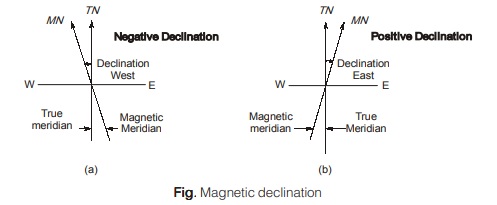MAGNETIC DECLINATION
- It is quite a common phenomenon that the magnetic meridian and the true meridian at a place generally do not coincide.
- The horizontal angle which the magnetic meridian makes with the true meridian is called as magnetic declination (also sometimes referred to as declination).

- Negative declination: When magnetic north lies towards the west of true north, then the declination is said to be negative.
- Positive declination: If the magnetic north lies towards the east of true north, then declination is said to be positive.
- The magnetic declination at a place can be measured in the field by establishing the true meridian by astronomical observations followed by determination of magnetic bearing of the line.
Isogonic lines
Declination varies from place to place and also from time to time at the same place. This variation of declination at different places is studied with the help of isogonic lines which are the lines passing through the points on earth’s surface having the same declination at a particular time. Now the earth’s magnetic field is not uniform and thus isogonic lines do not form the complete great circles. These lines radiate from the north and south poles of the earth and then follow irregular paths.
Agonic lines
A special case of isogonic lines are the agonic lines which represents the isogonic lines with zero declination. Thus at all the points on agonic lines, the true meridian and the magnetic meridian coincide.
<< Previous | Next >>
Must Read: What is Surveying?

